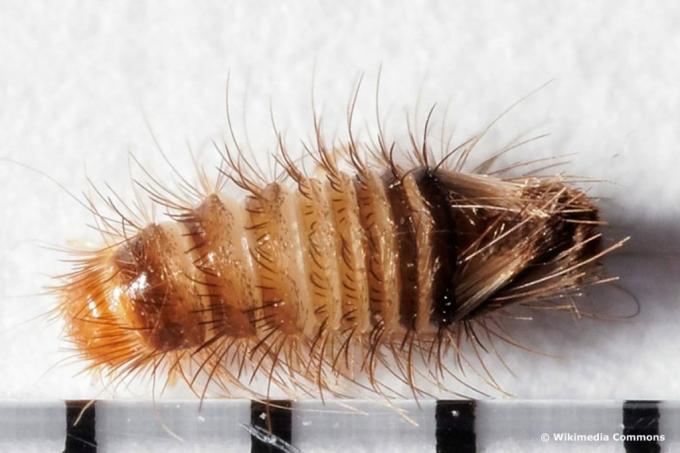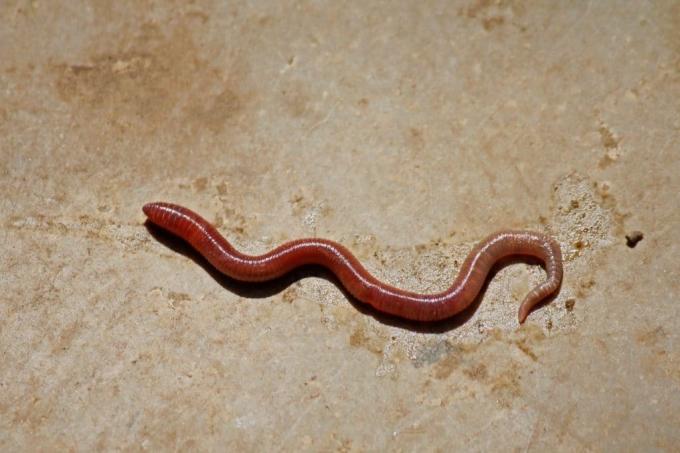
table of contents
- Recognize worms
- Species and their origins
- Carpet beetle (Anthrenus scrophulariae)
- Mealworms (Tenebrio molitor)
- House beetle (Opilo domesticus)
- Real worms
- Dragged in from the pool
- Preventing insects in the house
- frequently asked Questions
Small red worms in the house can cause disgust. You don't have to be afraid of them, they are completely harmless. Nevertheless, it makes sense to eliminate them quickly so that they do not spread.
In a nutshell
- Identify small red worms securely in order to be able to fight them properly
- alternatively, it can be insect larvae
- in rare cases worms come into the house from the pool
- various control measures are necessary
- The pests can be prevented through vigilance and thoroughness
Recognize worms
Fighting pests properly can only be successful if it is clear beforehand which species it is. While they can actually be real worms, it is much more likely that they are larvae of insects. In most cases, the difference should be visible to the naked eye. Worms have no limbs, not even the facilities to do so. In addition, they are not hairy. The larvae of flies also have no legs and are hairless, but maggots are usually whitish in color.
Note: Since real worms often live in the ground, they usually stay in the house near flower pots.
Species and their origins
Carpet beetle (Anthrenus scrophulariae)
The larvae of the carpet beetle are not exactly red, but they are so small that they cannot always be identified with certainty at first glance. At first glance, they often appear like little red worms. The hairiness of the larva is noticeable, its basic color is reddish-brown. The carpet beetle has a wide range of food, which is why it is considered a pest. Among other things, he eats:

- Wool
- silk
- Skins
- cotton
- leather
- horn
- feathers
Fighting it is not a problem with individual specimens, but it becomes more difficult with mass occurrences. Every larva and every beetle should be collected, and infested textiles or objects should be disposed of. Clothes can also be washed, but this is of no use if they already have holes.
Appearance of the beetle:
- only 5 mm in size
- mainly black
- white and brown spots on the elytra
Mealworms (Tenebrio molitor)
The mealworm is also not actually a red worm. It is the meal beetle larva. It is often whitish yellow, but sometimes also darker to reddish brown in color. As the name suggests, the mealworm eats in cereals and flours. So it is a food pest. Sometimes the origin is not apparent. It is possible that the animals were brought into the apartment with a new flour package, an infestation cannot be reliably prevented. Control options:

- Dispose of contaminated food
- carefully examine all dry supplies
- Catch and dispose of beetles and larvae
- First vacuum the larder thoroughly, then wipe it with a damp cloth
- check again after a few weeks
Note: Flour beetles and their larvae are good food for larger fish or terrarium animals. The beetles are uniformly black in color.
House beetle (Opilo domesticus)
The house beetle and its larvae are a special case; they are not pests. Instead, they are even beneficial insects because they eat wood pests. For this reason, they are found near wooden components that are infested by rodent beetles. The house beetle is brown in color, with yellowish spots on the wing covers. The larvae are colored differently, often with purple and red dots or spots, making them look like red worms from a distance. Far more important than fighting these larvae is getting rid of the rodent beetles in the wood. To be on the safe side, however, it is better to leave that to a specialist.
Real worms
These are most often simple earthworms. The smaller species in particular are markedly red in color. Since they only live in the ground, they are dragged into the house via potted plants. Sometimes it happens that they leave the earth to look for a new place to live. Then they can be found on the floor, for example. It is not necessary to fight them, it is sufficient to collect them and bring them into the garden.

Dragged in from the pool
In rare cases, small red ones can appear Worms from the pool be brought into the house. These are either mosquito larvae, which have little resemblance to real worms, or Tubifex, the brook tube worm. This occurs in various bodies of water and can get into the pool through well water, for example. The animals are completely harmless and are used as live food in the aquarium hobby. They cannot survive on land.
Preventing insects in the house
There are several ways to prevent insects and small red worms from entering your home. Insect screens on windows and doors are good and important protection. Above all, these prevent the ingress of flying insects that could multiply inside. More options:
- Check stocks, including newly purchased ones
- Transfer to airtight packaging
- Wash textiles made of natural fibers regularly and check for damage
- Treat wooden parts in the house with wood preservatives
- Put all potted plants in one room for the winter
- water carefully, earthworms leave the earth if there is too much water
- only use purchased soil for repotting
- If in doubt, sterilize your own soil in the oven
frequently asked Questions
In most cases, the insects are not harmful to health. However, some species can cause allergic reactions. This is especially true for hairy insect larvae.
Even if the animals cause disgust, a professional is usually not necessary to get rid of them. Real worms cannot reproduce in the home, or only to a limited extent, so they will disappear on their own.
This is not a good decision, as most poisons are also dangerous for pets, especially birds or terrarium / aquarium animals. A non-toxic option is pheromone traps, which are used to catch sexually mature pests.
